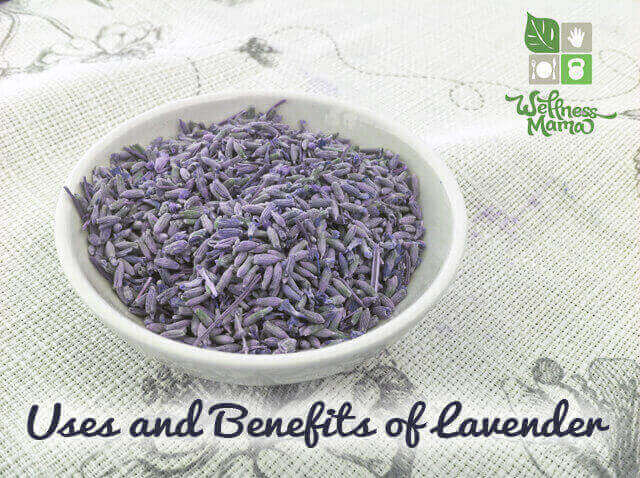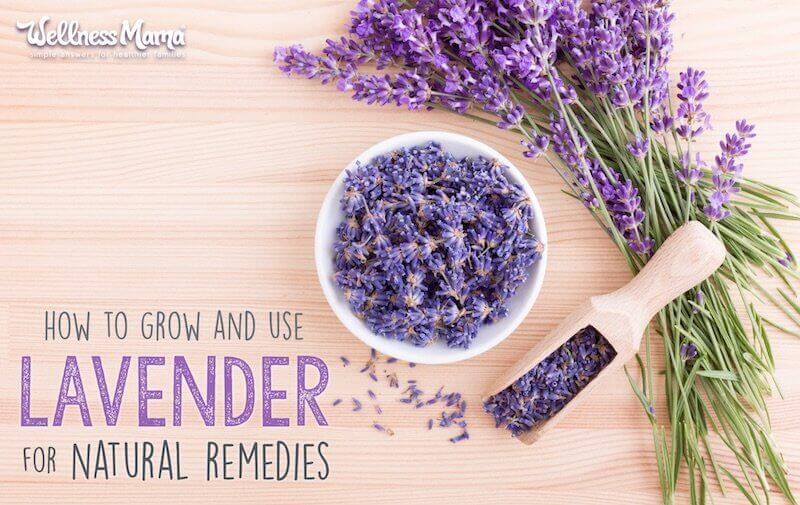It only takes a brief scroll through my home remedies and DIY recipes to know that lavender is by far one of my favorite herbs. Not only is is beautiful and fragrant in the garden, it has hundreds of uses (literally). It’s the constant staple in my essential oil stash and I use it just about daily in one way or another.
Lavender’s claim to fame is its ability to enhance relaxation and promote restful sleep. Best of all, unlike some essential oils that require a lot of caution, lavender falls on the safer side of the spectrum, making it a great choice to use around babies and kids. A natural remedy that helps my kids stay calm and get to sleep? Um, yes please!
Let’s see what else it can do …
Lavender: The Little Purple Flower With Power
Turns out there’s good reason (many good reasons) why lavender is a crunchy mama’s right hand helper in the home.
Originating from southern Europe and parts of Africa, Asia, and India, many ancient and medieval cultures relied on the herb not just for its signature scent but also its pain relieving and sedative properties.
Thanks to its linalool and linalyl acetate components (which are present even when diffusing), lavender has protective effects shown to:
- Stabilize mood
- Improve sleep
- Soothe nerves
- Work as an expectorant
- Balance blood sugar
- Kill bacteria
- Relieve pain
- Speed wound healing
Proven Benefits of Lavender
Here’s why the little purple flower packs such a powerful punch:
Lavender for Better Sleep
There’s a reason lavender is used in so many of my DIY creations. It is well known for its ability to relax the mind and improve quality of sleep. In one 2006 study, sleep-deprived college students inhaled either lavender or a placebo. Those who used lavender slept more soundly and felt more refreshed upon waking up.
More study is needed to determine whether it is safe to use during breastfeeding (it’s generally not recommended at this time), but it’s exciting to see emerging research on how lavender might help women during the crucial postpartum time. Improving postpartum sleep (or what little we mothers get anyway) sounds like a worthy cause to me!
Lavender for Anxiety and Depression
On a similar note, many studies show interesting applications for lavender for memory, mood, and overall cognitive function. Just the odor of lavender seemed to help various test groups stay relaxed and focused when asked to do various stressful tasks, or improved their ability to recover feelings of wellbeing after exposure to stress.
Researchers continue to examine the possibilities for lavender in the treatment of dementia, anxiety, depression, and various neurological disorders.
(I don’t know if those symptoms bring this to mind for anyone else… but lavender’s soothing effects also make it great for managing PMS!)
Lavender for Skin Care
Due to its anti-inflammatory effects and ability to scavenge free radicals, lavender has a place in skin care. As is so common in the health world, controversy surrounds the subject of whether it is a skin irritant or a skin protectant, but this article by Robert Tisserand explains the reasons why its benefits outweigh any risks. (Risks are slight, in his informed opinion).
Give lavender a try in your DIY beauty routine. Use a quality oil (I like Plant Therapy) and the proper dilution for skin. If there’s any concern about sensitive skin, try a test run on a small spot in the inner elbow.
Lavender for First Aid and Wound Healing
Studies (and much anecdotal experience) show that lavender reduces pain and itching from bug bites, bee stings, and even burns. In fact one 2011 study examined the benefits of lavender in healing episiotomies and another 2013 study showed lavender aromatherapy relieved pain after c-section.
Lavender for Hair Growth
A 2016 study on mice showed lavender is an effective proponent of hair growth and significantly increased the number and health of hair follicles when applied in proper dilution daily for a period of 4 weeks. The properties make it great for healthy, shiny hair in general. (Recipes for these treatments below.)
How to Use Lavender at Home
I use lavender in just about every area of my home. I keep both the dried herb and the essential oil around because they’re needed for different preparations.
While the options to use it are just about endless, here are a few of my favorite uses:
Dried Herb Uses:
- In a relaxing herbal tea – Lavender is too strong to be used by itself as a tea, but mixed with mint leaves it makes a soothing herbal tea. I often add chamomile too. Steep all in hot (not boiling water) for a few minutes and add honey if desired. Ahhh…
- As a dandruff remedy – Make an extra strong batch of tea, let it cool, and use as a scalp rinse to remedy dandruff. This cooled tea recipe also doubles as an after-sun spray.
- In a tincture – Used for medicinal purposes since ancient times, a lavender tincture can promote relaxation and sleep.
- Inside a pillow or mask – Add the dried flowers to homemade buckwheat pillows or sleep masks to help promote relaxing sleep.
- As a laundry or drawer freshener – I sew the dried flowers into small satchels and use them in place of dryer sheets in the dryer. (Great project for kids!)
- For infused vinegar – Infuse vinegar with the dried flowers for use in cooking or as a skin toner (diluted).
- As an air freshener – Simmer the dried herb in a pot of water with some citrus peels for a natural air freshener!
- As a face scrub – The dried flowers and oatmeal makes for a gentle, fragrant face scrub.
- In cooking! – It’s not so strange! Lavender flowers actually feature in this classic herbes de Provence spice blend.
Essential Oil Uses:
- Diffusing before bed – Put a few drops in an essential oil diffuser before bed to help the house wind down and get ready to sleep
- To sooth sunburns or other burns – My absolute favorite burn remedy is this lavender honey burn salve. In a pinch, add a few drops of the essential oil to a bottle of cool water and spray on burns to offer relief.
- In the bath – These DIY lavender-mint bath salts are divine after a long day and will help relax sore muscles.
- For headaches – Smelling lavender and peppermint oils helps headaches. Simply take a whiff of essential oil or keep this headache relief roll-on handy.
- In homemade bug spray – It is an essential ingredient in my DIY natural bug spray. (It works, I promise!)
- In beauty recipes – Add a few drops of the essential oil make a relaxing homemade lotion or lotion bar, or even a whipped body butter.
- For acne and skin irritations – I like to add a few drops of lavender and frankincense essential oils to my honey face mask and cleanser recipe.
- In a hair growth serum – As mentioned above, I include lavender in my hair growth serum, especially great for that fun time of postpartum hair loss.
Either Dried or EO:
- Salt Ear Infection Remedy – This hot pack is easy to make and such a lifesaver when an earache strikes!
Where to Buy Lavender (& How to Grow It)
My sources have varied over the years, but right now I like this source for the dried herb and this one for the essential oil. Of course the nice part is, you don’t have to buy lavender to have it around. It’s easy to grow in your own backyard and a cinch to maintain and harvest.
Since it’s pretty easy on the eyes (and the nose) as well, it’s a win-win!
Given its native regions, lavender grows best where the winter is mild and the summers are hot and dry, but it’s a forgiving plant. Visit a local nursery to find the variety best suited for your area. (Keep in mind different varieties have different blooming seasons, too.)
Lavender generally needs little water or fertilization and even grows well in pots. It’s important though that it is located in a sunny spot (6+ hours) and have good drainage. (In fact, add gravel to the potting soil if potting.)
Our plants have done well for years with little care or maintenance other than pruning them back each fall. I recommend picking a sunny spot by a walkway or door to enjoy its amazing scent every time you walk by!
Here is a detailed helpful post about when and how to harvest lavender flowers.
Is Lavender Essential Oil Safe?
Although natural, essential oils are extremely powerful and need to be respected. I personally do not use any essential oils internally (here’s why). There is some evidence that long term regular use of concentrated lavender can cause hormone imbalance in males, so I generally avoid it in things I am making for my husband or sons. I don’t use even the dried or fresh herb internally when pregnant.
Due to its relaxing properties, I would not use in conjunction with any medication that also causes relaxation or sleepiness.
Using Lavender Around Kids
Using essential oils around children definitely calls for some caution and care. I’ve had many reputable doctors and aromatherapists assure me that lavender is one of the safest oils to use around babies and kids, but there is still a right and wrong way to do it.
Plant Therapy’s Kid-Safe oils are a great way to take the guesswork out of selecting essential oils, and their website and blog are my go-to these days for essential oil information since they are backed by Robert Tisserand, one of the world’s leading experts in aromatherapy.
This article was medically reviewed by Jessica Meyers, MPAP, PA-C, RH(AHG), who specializes in herbal protocols and functional medicine. You can also find Jessica on Instagram. As always, this is not personal medical advice and we recommend that you talk with your doctor.
Do you use lavender? What is your favorite way to use it? Share below!





Leave a Reply